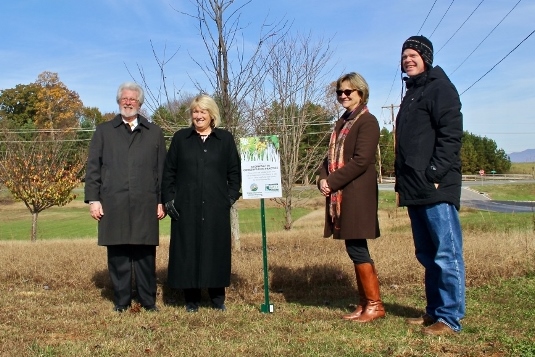
Suburban and urban land owners throughout the Virginia Chesapeake Bay watershed are taking the initiative to improve water quality by installing stormwater management projects on their properties. More than 140 stormwater projects have been completed and 258 are set to begin this year, funded by Virginia Soil and Water Conservation Districts’ cost-share program, Virginia Conservation Assistance Program (VCAP).
Property owners installing Best Management Practices (BMPs) in Virginia’s Chesapeake Bay watershed can access financial incentives of up to 75 percent cost-share along with technical and educational assistance, thanks to a 2017 grant from the National Fish and Wildlife Foundation’s Chesapeake Bay Stewardship Fund.
Locally, the Bay watershed extends into portions of Botetourt, Craig, Giles and Montgomery counties, all just to the north of Roanoke.
Improvements that are eligible for VCAP assistance include conservation landscaping, constructed wetlands, dry wells, green roofs, bioretention, permeable pavement installation, rain gardens, and more. All of the projects have a 10-year maintenance contract. According to Virginia Association Soil and Water Conservation Districts, Virginia homeowners will make private investments of more than $2.2 million to augment / complete these projects.
Located east of Lynchburg, Forest Presbyterian Church (Forest VA) has been inundated with much of the runoff from a nearby highway. Although located in southwest Virginia, the property drains into the James River which feeds into the Bay. Church member Melissa Johnson is a “Cleanwater Captain”—an ambassador for clean water in her community—so she knew how to act to protect the space. With help from the Peaks of Otter Soil and Water Conservation District Director and VASWCD Past President, Richard Chaffin, and Dr. Harvey Proctor, former White House landscape designer, together they created a conservation landscaping plan to better handle the runoff.
“It’s all about educating people about caring for creation and serving a cleaner Bay. I’m actually overwhelmed by the attention—it seemed like a no-brainer. It’s not about the individual project itself, it’s about educating others about a cleaner Bay,” said Johnson.
With new plantings of native grasses, the property will be able to slow down and filter much of the stormwater runoff, helping to keep pollutants from entering local waterways. The property will receive the second phase of plantings beginning this spring.
Homeowner and “Master Naturalist” Sandee Bailey, of Henrico, Virginia, used VCAP to revitalize the “ecosystem” that is her back yard, enabling her to implement landscaping upgrades that also contribute to cleaner local waterways. She learned about VCAP through the Virginia Master Naturalists, a community-based natural resources volunteer program.
Before implementing stormwater projects, Bailey’s property had little sign of greenery. Since installing two dry wells and conservation landscaping including the establishment of a riparian buffer and a large swath of native plantings, she has seen many native species such as butterflies, moths, foxes, crayfish, turtles and over 100 different species of birds returning to her property. She has even spotted the Black-bellied whistling duck, a special visitor, which is rarely seen in the Eastern United States.
“You cannot imagine the difference this project has made for us. We gained four seasons of natural beauty and, by slowing the stormwater runoff, we helped our lake, the James and the Bay. I smile whenever I catch sight of an eagle snagging a fish or an otter munching on a crayfish, knowing that I’ve done my part to help keep the waters healthy,” said Bailey.
Her acreage is not the only beneficiary of the stormwater management installations. With the riparian buffer filtering stormwater and runoff, Bailey’s part of the lake in her back yard is noticeably cleaner after receiving significant rainfall.
Since the initial pilot program in 2012 was launched by four of the now 30 Virginia Conservation Districts that are partially or wholly in the Chesapeake Bay, the available cost-share funds equate to $250,000 to landowners in 2016; $575,000 in 2017, and currently $700,000 through 2018.
Dr. Kendall Tyree, Executive Director of Virginia Soil and Water Conservation Districts, said “we are so excited about the growth of this program. The history of Virginia Soil & Water Conservation Districts may be rooted in agriculture, which still remains important to our story, but districts have evolved to meet the full range of water quality needs in their communities. VCAP is a prime example of this transition. Demand for the program remains larger than our funding streams, so our work is far from over.”
For more information visit www.vaswcd.org/vcap
Alexis Janney


